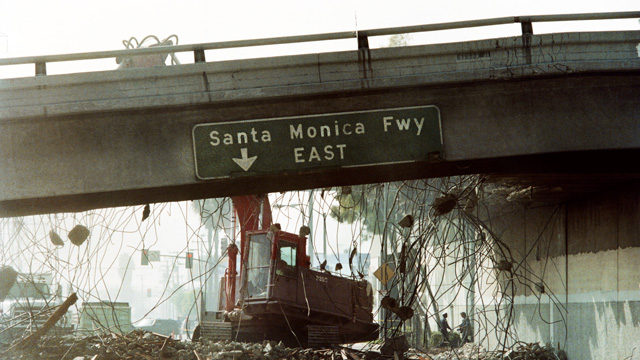The epicenter of the 6.7-magnitude quake was in the north-central San Fernando Valley, but people as far away as Las Vegas, San Diego and Ensenada, Mexico, reported feeling the shaking.
The official death toll was 57, although as many as 72 were counted dead as a result of the quake and more than 9,000 were injured.
A parking garage at California State Northridge collapsed, crushing the cars underneath. Even Los Angeles City Hall suffered serious damage, and its hundreds of employees were relocated. Several freeways collapsed, and fire and utility workers scrambled to put out more than 100 fires and to restore power.
Lessons From the Quake
Earthquake experts were taken off guard. The shaking happened along a previously unknown blind thrust fault, 11 miles below the Earth’s surface. The Northridge earthquake prompted an unprecedented mapping of the blind faults crisscrossing Los Angeles.
“We set off little explosions to create seismic waves and recorded them on seismometers to make a picture of the underground,” said Lucy Jones, a seismologist with the U.S. Geological Survey. “We’ve now got a much better picture that’s an extraordinarily complete evidence of what are the underlying faults.”
Northridge also helped researchers better understand how L.A.’s soft soil amplifies the shaking.
“Think of it as a bowl of Jell-O,” said Kate Hutton, a seismologist at the California Institute of Technology. “And you shake the bowl just a little bit, and the Jell-O goes crazy. I mean it flops back and forth because it’s soft. And the same thing is true with the sediments in the ground.”
Building standards already were upgraded after the 1971 Sylmar quake, and codes were revised for things such as steel welding after the Northridge quake. But Los Angeles still has hundreds of buildings that need costly seismic retrofits. L.A. officials are working to catch up with San Francisco, which passed a landmark earthquake safety ordinance last year.
Mapping the Faults
Aside from retrofitting, there’s also the ongoing need to map all the state’s faults.
“The worst risk, in terms of the consequences, is to have a building right on top of a fault -- a surface fault -- rupture, because the foundation is disrupted,” Hutton said. In the case of a large earthquake, she said, the building has “not much chance at all of surviving.”
The maps are required under the state’s Alquist-Priolo Earthquake Fault Zoning Act. Developers are required to conduct tests before building within 500 feet of an active fault. But to enforce that, cities and counties are waiting for the California Geological Survey to finish mapping the state’s faults. Because of budget cuts, only about two-thirds of the states’ faults have been mapped.
A controversial $200 million residential and commercial development called Millennium Hollywood prompted the California Geological Survey to speed up the mapping of the Hollywood fault. Preliminary seismic maps released last week show that a fault lies close to where two skyscrapers would be built.
“Now if you are in a proposed zone that is on this map now, and if you are planning to build a project there, it would be a wise idea, definitely, to do an investigation,” said Janis Hernandez, a state engineering geologist who worked on the Hollywood fault map. “And now that the cities and counties have this preliminary zone map, they will be requiring the additional information.”
Gov. Jerry Brown released his proposed state budget last week, which includes $1.5 million this year for completing seismic maps and $1.3 million for following years. That would reverse years of budget cuts and staff reductions. Despite those cuts, improvements in technologies such as aerial imaging have sped up the process of mapping fault lines.
“Now we’re getting really good at putting all these different kinds of high technology to work, studying the earthquake hazards here in Southern California,” said Ken Hudnut, a geophysicist with the U.S. Geological Survey.
But while technology has improved dramatically since Northridge, it has also left scientists more vulnerable to earthquakes.
“We rely a lot on cell modem communications, and as most people know, the cell phone will not work after a major earthquake,” said Egill Hauksson, a seismologist at Caltech. “So we worry that our data streams will not be flowing after a major earthquake.”
Planning Ahead
What the public wants to know, and what scientists have been unable to produce, is the ability to predict earthquakes.
“We have 50 earthquakes every day in California. What we’re trying to predict is what’s different about a big one,” said Lucy Jones of the USGS. “And as far as we can tell, the big and the small ones start the same way.”
So, scientists instead are leaning toward giving the public as much time as possible to prepare. A prototype for an earthquake early-warning system has been developed, and federal and state funds are being secured to roll it out statewide.
And this week Los Angeles announced it has partnered with Lucy Jones and the U.S. Geological Survey to create a comprehensive earthquake safety plan. That plan is due out by the end of the year.

